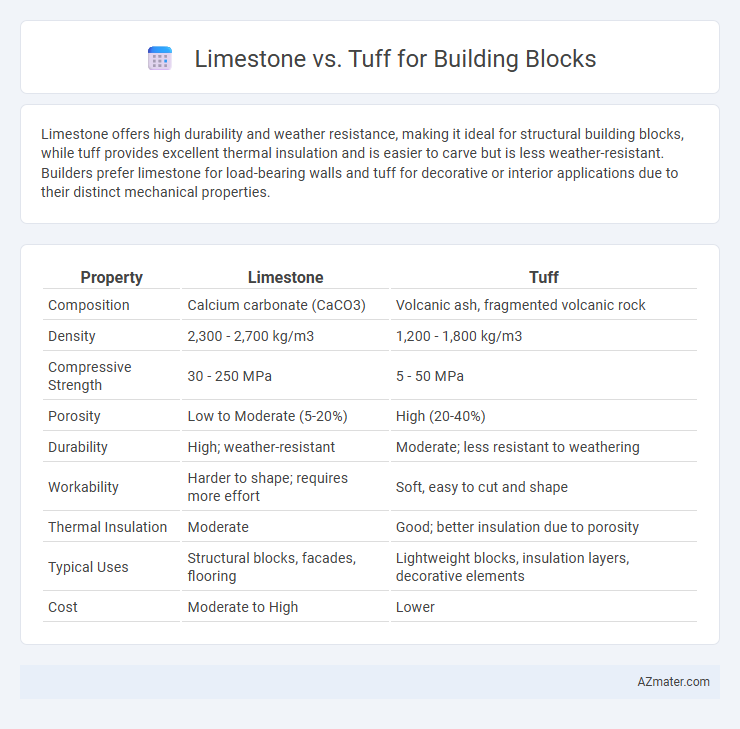Limestone offers high durability and weather resistance, making it ideal for structural building blocks, while tuff provides excellent thermal insulation and is easier to carve but is less weather-resistant. Builders prefer limestone for load-bearing walls and tuff for decorative or interior applications due to their distinct mechanical properties.
Table of Comparison
| Property | Limestone | Tuff |
|---|---|---|
| Composition | Calcium carbonate (CaCO3) | Volcanic ash, fragmented volcanic rock |
| Density | 2,300 - 2,700 kg/m3 | 1,200 - 1,800 kg/m3 |
| Compressive Strength | 30 - 250 MPa | 5 - 50 MPa |
| Porosity | Low to Moderate (5-20%) | High (20-40%) |
| Durability | High; weather-resistant | Moderate; less resistant to weathering |
| Workability | Harder to shape; requires more effort | Soft, easy to cut and shape |
| Thermal Insulation | Moderate | Good; better insulation due to porosity |
| Typical Uses | Structural blocks, facades, flooring | Lightweight blocks, insulation layers, decorative elements |
| Cost | Moderate to High | Lower |
Overview of Limestone and Tuff as Building Materials
Limestone is a sedimentary rock composed primarily of calcium carbonate, prized for its durability, ease of cutting, and natural aesthetic in construction. Tuff, a volcanic rock formed from compacted ash and debris, offers lightweight properties and excellent thermal insulation, making it suitable for energy-efficient buildings. Both materials provide unique advantages: limestone with its strength and classic appeal, and tuff with its insulating capabilities and lightweight nature.
Geological Formation and Composition
Limestone is a sedimentary rock primarily composed of calcium carbonate, formed through the accumulation of marine organism remains in shallow, warm marine environments over millions of years. Tuff is an igneous rock formed from volcanic ash ejected during explosive eruptions, which subsequently compacts and solidifies into a porous, lightweight material. The contrasting geological formations influence their durability and suitability as building blocks; limestone offers strong compressive strength due to its dense crystalline structure, while tuff provides excellent insulation properties but generally lower structural strength because of its porous volcanic origin.
Physical Properties Comparison
Limestone exhibits higher density and compressive strength, typically ranging from 2.3 to 2.7 g/cm3 and 30 to 250 MPa, making it more durable for structural applications. Tuff, with its porous texture and lower density of about 1.5 to 2.0 g/cm3, offers better thermal insulation but reduced strength, usually between 5 to 30 MPa. The choice between limestone and tuff hinges on balancing load-bearing capacity versus insulation properties for building blocks.
Durability and Weather Resistance
Limestone offers moderate durability with good resistance to weathering but can be prone to erosion and surface wear in harsh climates due to its sedimentary nature and relatively softer composition. Tuff, a volcanic rock, excels in weather resistance and durability because of its porous structure and high mineral content, making it less susceptible to cracking and spalling under extreme temperature fluctuations. Choosing tuff over limestone for building blocks ensures enhanced longevity and reduced maintenance in environments with heavy rainfall, freeze-thaw cycles, or corrosive atmospheric conditions.
Workability and Ease of Shaping
Limestone offers excellent workability due to its relatively uniform texture and moderate hardness, making it easier to cut and shape with basic masonry tools. Tuff, being a volcanic rock, is softer and more porous, which allows for easier carving and handling but may require careful treatment to ensure durability. Both materials are favored in construction for their shapeability, though limestone provides greater precision in detail while tuff supports rapid shaping with less effort.
Aesthetic Qualities and Color Variations
Limestone offers a refined, smooth texture with color variations ranging from creamy white to warm beige, enhancing classic and elegant architectural styles. Tuff exhibits a porous, rugged surface with a spectrum of colors including soft pinks, reds, and greys, lending a rustic and natural appearance to buildings. Both materials provide distinct aesthetic qualities that influence design choices based on desired visual impact and environmental harmonization.
Environmental Impact and Sustainability
Limestone, a sedimentary rock, has a lower environmental impact during quarrying due to its abundance and ease of extraction, resulting in less energy consumption compared to tuff, a volcanic rock often mined from quarries with higher ecological disruption. Limestone's high calcium carbonate content allows for recyclability and carbon sequestration when used in cement production, enhancing sustainability. Tuff, while offering good insulation properties and durability, involves more intensive mining processes and limited recyclability, affecting its overall environmental footprint negatively.
Cost and Availability
Limestone is widely available and generally more affordable than tuff, making it a cost-effective choice for building blocks in many regions. Tuff, while sometimes more expensive due to limited local deposits, offers enhanced insulation properties and aesthetic appeal. The availability of limestone is greater globally, whereas tuff is often restricted to volcanic areas, impacting its overall accessibility and price.
Common Applications in Construction
Limestone is widely used for building blocks in both residential and commercial construction due to its durability and attractive appearance, often employed for walls, facades, and flooring. Tuff, a volcanic rock, is favored in regions with seismic activity for its lightweight and insulating properties, commonly used in load-bearing walls and decorative elements. Both materials offer unique benefits, with limestone excelling in strength and weather resistance, while tuff provides better thermal insulation and ease of carving.
Choosing Between Limestone and Tuff for Your Project
Limestone offers superior durability and a classic aesthetic, making it ideal for long-lasting structural and decorative building blocks, while tuff provides excellent insulation and is lighter, reducing construction load. Consider local availability, climate, and structural requirements when choosing between the two; limestone is favored for high-strength projects, whereas tuff suits environments needing thermal efficiency. Cost and ease of cutting also influence decisions, with tuff typically being more economical and easier to shape compared to denser limestone.

Infographic: Limestone vs Tuff for Building Block
 azmater.com
azmater.com